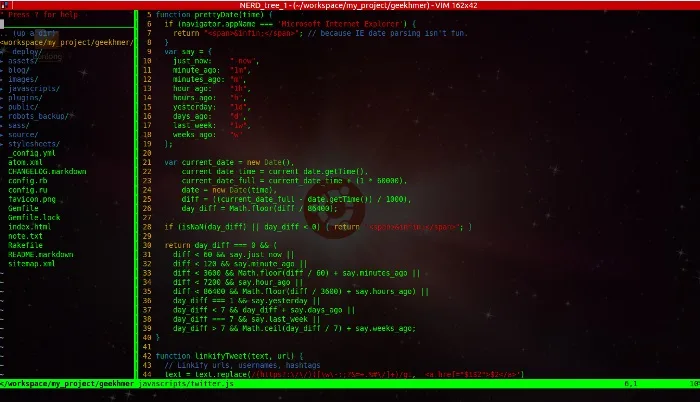
VIM Coding Software Review
Vim is a highly configurable text editor built to enable efficient text editing. It is an improved version of the vi editor distributed with most UNIX systems. Since its release in 1991, Vim has become one of the most popular text editors among programmers, system administrators, and those who frequently interact with terminal environments.
Initially developed by Bram Moolenaar, Vim stands for “Vi Improved.” Its creation aimed to provide an enhanced user experience for those already familiar with vi. Vim is widely known for its speed, flexibility, and the steep learning curve associated with its use. Despite its complexity, Vim has gained a dedicated user base and remains relevant in modern programming due to its efficiency and adaptability.
How is Vim Structured and How Does it Work?
Vim operates in multiple modes, the most common being Normal mode and Insert mode. In Normal mode, users can navigate through the text and perform editing tasks without directly inserting characters. Commands are used to perform actions such as deleting, copying, and moving text. In Insert mode, Vim behaves more like a traditional text editor, allowing users to insert characters into the text.
Another key feature of Vim is its extensive configurability. Users can modify key bindings, install plugins, and write custom scripts to optimize their workflow. Vim’s configuration file, known as .vimrc, allows users to personalize their experience by automating tasks and adapting the interface to suit their needs. This level of customization is one reason Vim has maintained its popularity over the decades.
What Known Projects Were Created Using Vim?
Many prominent open-source and proprietary projects have been developed with the help of Vim. Among the most notable is the Linux kernel, which benefits from the editor’s lightweight and efficient nature. Similarly, Vim has been integral to the development of various GNU utilities, where its command-line interface offers programmers the ability to quickly edit configuration files and scripts.
Other noteworthy projects include Mozilla Firefox, where developers use Vim to contribute to the open-source browser’s codebase. Additionally, major companies such as Google and Facebook have engineers who rely on Vim for tasks ranging from server management to coding complex algorithms.

Vim’s Interface and Design
Vim’s interface is minimalistic, focusing on functionality over aesthetics. The editor runs within the terminal, offering a distraction-free environment for developers. While the default interface lacks modern graphical elements, Vim’s power lies in its keyboard-centric navigation, which allows users to perform actions faster than they could with a mouse.
The interface can be extended with themes, plugins, and graphical versions like GVim. Plugins like NerdTree and CtrlP introduce file explorer capabilities and fuzzy searching, providing an enhanced user experience. These additions bridge the gap between Vim’s traditional interface and modern IDEs without sacrificing performance.
How Promising is Vim in the Future?
Despite being over 30 years old, Vim remains relevant in the modern coding ecosystem. The flexibility offered by its extensive plugin architecture ensures that the editor continues to evolve with user needs. New plugins and community contributions expand Vim’s functionality, keeping it competitive with modern Integrated Development Environments (IDEs).
Vim’s lightweight nature, combined with its versatility and integration with UNIX systems, suggests it will continue to be a favored tool among developers who prioritize speed and efficiency. Moreover, the growing trend of terminal-based development environments, especially in remote server management and cloud infrastructure, further solidifies Vim’s long-term prospects as a go-to tool for programmers.
Popular topics
-
 Google Trends. What is it and how to use it?
Google Trends. What is it and how to use it?This service makes it possible to quickly analyse current trends, …
-
 Evolution of Corporate Software: From Local Solutions to ...
Evolution of Corporate Software: From Local Solutions to ...Corporate software has undergone a fundamental transformation over the last …
-
 VIM Coding Software Review
VIM Coding Software ReviewVim is a highly configurable text editor built to enable …
-
 How to choose hosting
How to choose hostingAny modern site or portal needs high-quality hosting. But questions …
-
 Duolingo – Language Learning Through Gaming
Duolingo – Language Learning Through GamingDuolingo is one of the most popular mobile apps for …
